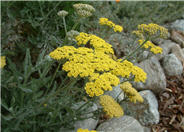
Common name:Moonshine Yarrow
Botanical name:Achillea 'Moonshine'
'Moonshine' is an upright, clump-forming, compact hybrid yarrow, with deeply-dissected, fern-like, aromatic, silvery to gray-green foliage. Flowers are long-lasting, bright lemon-yellow, and bloom throughout the summer on stiff, erect stems. This plant resembles A. 'Coronation Gold' except it is much smaller and the flowers are a lighter yellow. Grows about 18 inches tall and 24 inches wide, and seems to be slightly less invasive then other yarrow, keeping a more clumping habit. A great addition to a sunny perennial border.

Common name:Karl Foerster Feather Reed Grass
Botanical name:Calamagrostis acutiflora 'Karl Foerster'
Karl Foerster feather reed grass is a garden favorite, and for good reason. Its green, fine-textured foliage is gently arching and grows to about 2 feet tall and wide. Oat-like plumes stand very erect over the foliage, growing as tall as 5 to 6 feet. Plumes open whiteish green, later turning a dusky rose, and then tawny colored by winter. Blooms early summer with the plumes lasting into autumn. Holds its presence well into winter. Excellent in mixed perennial or shrub borders, or massed.

Common name:European Grapevine
Botanical name:Vitis vinifera
Grapes are a wonderful addition to a garden, even without the fabulous fruit. Grapes are fast growing, and given a proper structure to scramble on, will provide screening and shade. Many species are available that grow along the Wasatch Front, even wine varieties. A very woody, twining, tendrilling vine, they need substantial support. Fruit generally begins to ripen late summer to early fall, depending on the variety. Young leaves can be pickled. Some have lovely fall color. Grows 15 to 25 feet tall and wide.
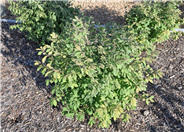
Common name:Compact Burning Bush
Botanical name:Euonymus alatus 'Compacta'
"Compacta" is a dwarf form of burning bush, growing 6 to 8 feet tall and wide. Like the speices, leaves emerge in the spring a bright, luminous green, mature to a dullish medium to dark green, and turn a brilliant scarlet to burgundy in the fall. After the leaves drop, the interesting wood is exposed, with corky "wings" along the length of the stems. New wood displays green and brown wood, older wood is a warm grey brown. Little yellow flowers appear May and June, and though not showy, they are charming.
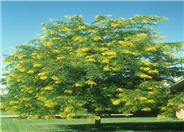
Common name:Sunburst Honeylocust
Botanical name:Gleditsia triacanthos 'Sunburst'
Sunburst honeylocust is slightly smaller than the species, growing about 30 to 35 feet tall and 20 to 30 feet wide. It has the same upright, spreading habit that makes it a fine choice as a shade tree. Leaves are small and pinnately compounded, but the new growth is always bright yellow which contrasts attractively with the darker yellow green interior foliage. Deciduous.
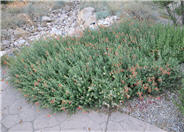
Common name:Arizona Fuchsia
Botanical name:Zauschneria arizonica
The Arizona fuchsia is a showy perennial shrub that grows 2 ft. tall with upright, erect growth habits. The large scarlet flowers are set off by the dark green foliage. This shrub is drought tolerant and attracks hummingbirds. -Cornflower Farms
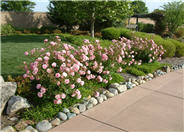
Common name:Meidiland Varieties Rose selections
Botanical name:Rosa x Meidiland Varieties
Meidiland roses are nearly ubiquitous in commercial and institutional landscapes, offering summer-long color and surprising durability for a rose. Generally growing about 1 to 2 feet tall with a spread of about 4 to 5 feet, they have a pleasant arching habit that makes them useful as a sort-of groundcover, or for cascading over walls. They do not require deadheading to remain flowering, and bloom from May to frost. Available in a variety of reds, pinks, and white. Dark green foliage and hips that ripen red in the fall, persisting into winter.
| Designer: Rick Laughlin | Grass Ranch 22 |
Photographer: GardenSoft |
Water Saving Tip:
Check the soil's moisture level before watering.
You can reduce your water use 20-50% by regularly checking the soil before watering.
